Investing in individual stocks is of interest to many investors, but some avoid it because it can be too risky for their level of experience.
The best investment websites may help the average investor by providing suggestions about purchasing individual stocks and minimizing risk.
With these sites, you can receive expert-researched stock recommendations that might help you reach your investing goals.
These stock picks can be less risky than investing by yourself and can make researching investment ideas even easier.
Top Investment Sites
When you are just beginning to diversify your portfolio or want to own stocks that provide steady dividends, you only need to buy individual stocks that should outperform the market for the next three to five years.
While you can make a fortune trading options, shorting stocks, or investing in penny stocks, you should leave these investing strategies to the pros.
Here are the best sites to check out if you are looking for investment advice.
1. Motley Fool Stock Advisor
Best for picking individual stocks

When you’re ready to buy individual stocks, you should consider Stock Advisor from The Motley Fool.
Stock Advisor is one of the best investment websites for new and experienced investors since you’ll get access to several investing ideas as soon as you subscribe.
Since the service launched in 2002, brothers David and Tom Gardner release two new picks each month. David’s picks alone have outperformed the S&P 500 by 513.8%! Tom’s picks have outperformed the same benchmark by 88%.
While your S&P 500 index funds held during the same time period would have grown 93% by tracking the market performance, picking the right individual stocks can help you actually beat the market.
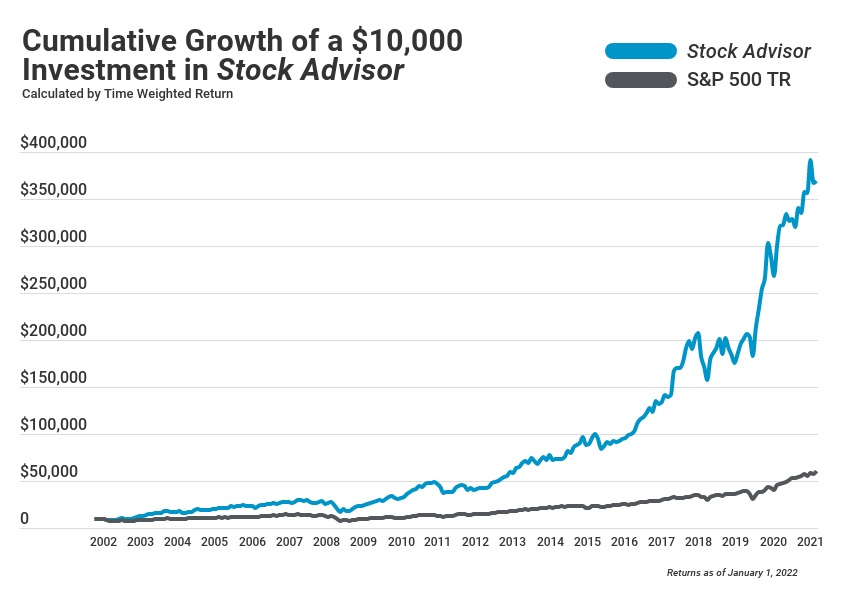
Each stock pick includes a short research report describing the company, reasons to invest in the stock now and why you might avoid the stock or sell your shares.
New investors may also appreciate the Starter Stocks list. This premade list recommends 10 stocks that the Stock Advisor team believes are a good fit for most portfolios. These stocks are for well-known companies.
Each starter stock can be less volatile than a monthly stock pick but still has plenty of growth potential.
Stock Advisor recommends that investors buy at least three Starter Stocks before buying shares of the new monthly picks.
Before buying any stock recommendation, be sure to perform your own research separate from the investment site report.
Take the time to understand how the company makes money and how it can lose money or underperform the market.
Investment Philosophy
Stock Advisor is a good option for long-term investors as they believe in owning stocks for several years before selling. You will need to be comfortable holding a stock pick for the next three to five years.
Other investment sites may promote short-term trades or use a “stop-loss” to sell your shares if the share price falls below a certain dollar amount or percentage from your initial purchase price.
Each stock pick recommends a company with multi-year growth potential. All stock picks are modeled after the investment philosophies of David and Tom Gardner, the co-founders of The Motley Fool.
One monthly pick is from “Team David” and the second pick is from “Team Tom.”
To help you understand David and Tom’s investment philosophies, here’s The Motley Fool explanation:
It’s a generalization to be sure, but David swings for the fences. He’s willing to take the occasional stumble, so long as his total portfolio is up. Tom, on the other hand, never wants to see one of his stocks down 20% or 30%. He prefers to score runs consistently through constant base hits; David’s more about home runs. You may be somewhere in between. That’s why it’s important that you pick your investments on a stock-by-stock basis, just like we do.
Although you don’t have to buy every recommendation, you need to buy several of them to be a successful investor.
Stock Advisor only recommends you sell a stock when it appears the company won’t outperform the market for the next three to five years.
How Much Does Stock Advisor Cost?
An annual subscription to Stock Advisor for new members is only $99 (normally $199) or you can pay $19 per month. With either option, you get a 30-day money-back guarantee.
Stock Advisor is a bargain for the caliber of investment advice you receive. Similar newsletters only provide one monthly pick and don’t have a “starter stocks” list.
Pros
- Two monthly stock picks
- Excellent stock screener filter options
- Community discussion boards
- Exclusive investment research and podcasts
Cons
- Doesn’t cover ETFs
- Requires annual membership
- Not every stock makes money
Learn More: Motley Fool Stock Advisor Review
2. Seeking Alpha
Best investing site for analysis of stocks and ETFs
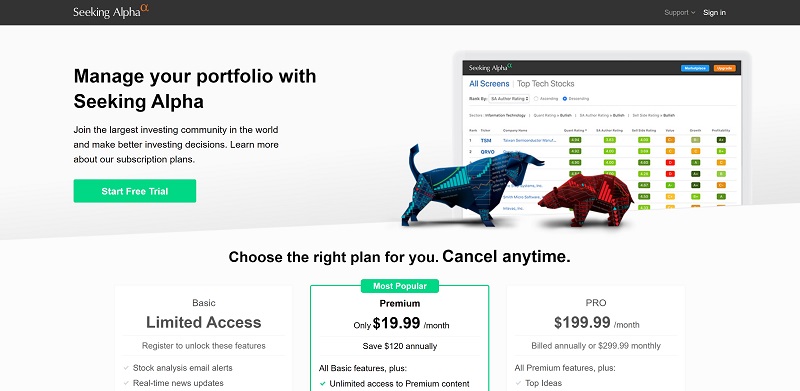
Seeking Alpha is arguably one of the best free investment sites. I personally subscribe to the daily Wall Street Breakfast email that includes a quick summary of the market’s top headlines.
This newsletter lets me quickly track any recent moves for the positions I hold and stocks on my watchlist.
You can also read articles to get investing ideas and review market commentary from Seeking Alpha contributors.
There are articles that list the bull case and bear case for a stock or ETF. I use these articles during the research phase to better understand an investment recommendation before deciding to buy or avoid.
Investors who make several trades each month can benefit from Seeking Alpha Premium ($19.99/month if paid annually).
Premium members also get access to a “Quant Ratings” system that can make screening stocks easier.
Seeking Alpha recently launched their stock picking service called Alpha Picks where you get 2 stock picks to buy and hold per month. Normally $199 per year but you can get for only $99 with this link here.
Related: Seeking Alpha Vs Motley Fool: Which is Better?
Pros
- Covers most stocks and ETFs
- Unlimited access to investing ideas articles
- Quant Ratings for most stocks
- Can track personal portfolio performance
- Listen and download company call transcripts and presentations
Cons
- Plan fees can be too high for casual investors
- Few technical analysis tools
- Doesn’t recommend stocks to buy
- Minimal coverage for mutual funds
Learn More: Seeking Alpha Review
3. Stock Rover
Best for stock research and tracking
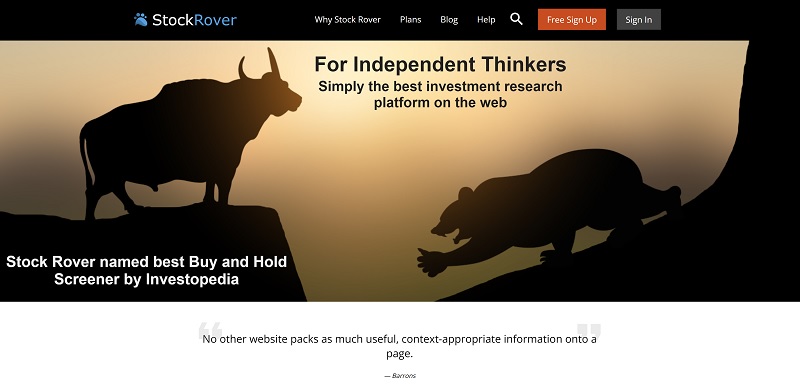
Stock Rover is a great service to get solid research for stocks. They offer three plans: Essential, Premium, and Premium Plus. Each one offers levels of investment data, charts, ratings, margins of safety, and more.
Many investors think Stock Rover has one of the top stock screeners. In addition to evaluating potential investments by a specific metric, Stock Rover lets you find stocks by “guru strategy.”
These custom screens model the methods that famous investors use to research stocks.
The Premium and Premium Plus plans will also monitor your portfolio. As your portfolio needs periodic rebalancing, Stock Rover will recommend potential trades.
This extra eye can be helpful when you want advice for managing your portfolio.
Pros
- Powerful stock screener
- Interactive charting tool
- Multiple stock ratings
- Automatic portfolio tracking
- Mobile-friendly
Cons
- Numerous plan options can be confusing
- Research reports may not be worth the upgrade
- Platform layout can be confusing
Learn more: Stock Rover Review
4. Morningstar
Best investing site for mutual fund research
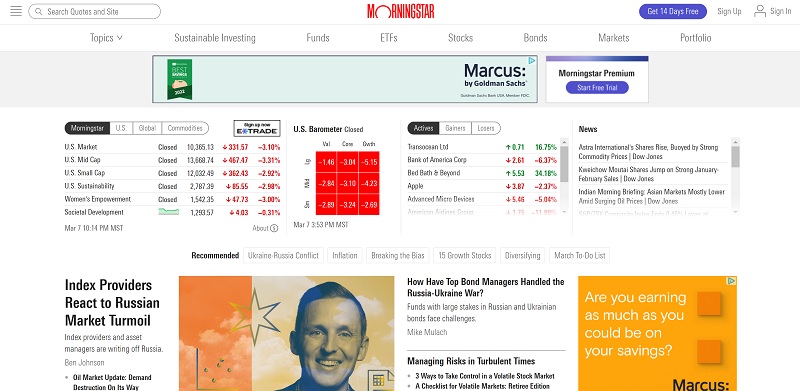
One of the most widely respected investment rating sites is Morningstar. This site can be best for researching mutual funds and ETFs, but Morningstar analysts also research stocks.
You may already be familiar with Morningstar because free investing apps use Morningstar ratings to help you screen prospective investments.
For example, a fund with a 5-star rating may have the top historical performance for its category.
As a disclaimer, excellent past performance doesn’t guarantee similar results in the future. That said, the ratings can help you find stocks and funds that you may choose to add to your investment portfolio.
Like other investment sites, you can access many free articles and video interviews to help you understand the markets and investing ideas.
These articles, along with a stock screener and portfolio tracker, come with a free Morningstar Basic membership.
For in-depth analyst reports and a list of Morningstar’s favorite investments, you must purchase a premium subscription ($199 annually).
Morningstar Premium also includes additional stock screener and portfolio analyzer features.
Sign up for their 7-day free trial and get up to $50 off an annual membership with this link.
Pros
- Research depth
- Easy to use
- Free trial
Cons
- High costs
- Clunky interface
Learn More: Morningstar Review
5. Zacks
Best for stock picks and in-depth analysis
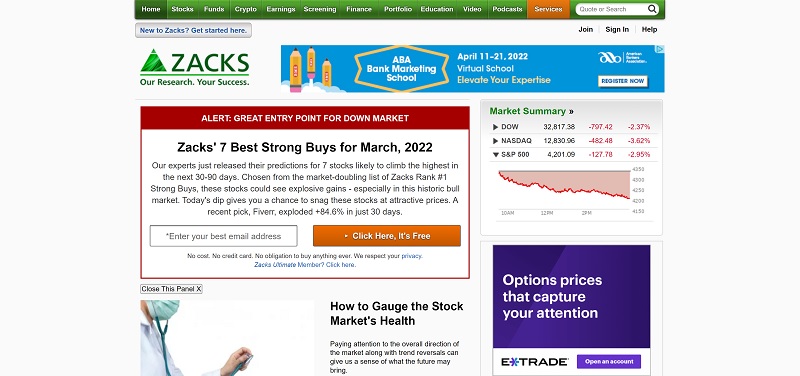
Zacks provides some free investing commentary on potential investments. You can use Zacks to find long-term and short-term investing ideas and learn more about the stock market.
To access the premade investment rank lists and in-depth analyst reports, you will need to join Zacks Premium. This service costs $249 per year after a 30-day free trial.
Want to try Zacks out? Download their free report on 5 Stocks Set to Double.
While any investor can benefit from Zacks Premium, it’s probably a better option if you follow a particular investment strategy.
The Zacks stock screener can filter by:
- Growth
- Value
- Earnings Surprises
- Best Industries
While Zacks has a robust stock screener, its “Rank Lists” can be an effective way to find stocks. There are lists for different industries and investing strategies.
Zacks also assigns each potential investment a score.
A higher score indicates the stock may have better investment performance.
In addition to the Zacks Rank Lists, you can read in-depth reports for each stock. These reports can describe the current pros and cons.
At $249 a year (after the 30-day free trial), you do get valuable research. Keep in mind you’ll have to invest more money so your investment returns can “pay” the annual subscription fee.
If you still need to buy your first stock, Zacks might not be the best option until you establish your investment strategy.
Pros
- Low fees
- Great customer service
- Great trade research tool
- Cost-effective trading
Cons
- Not all features on mobile platform
- High annual cost
Learn More: Zacks Premium Review: Is It Worth It?
6. Investopedia
Best for paper trading
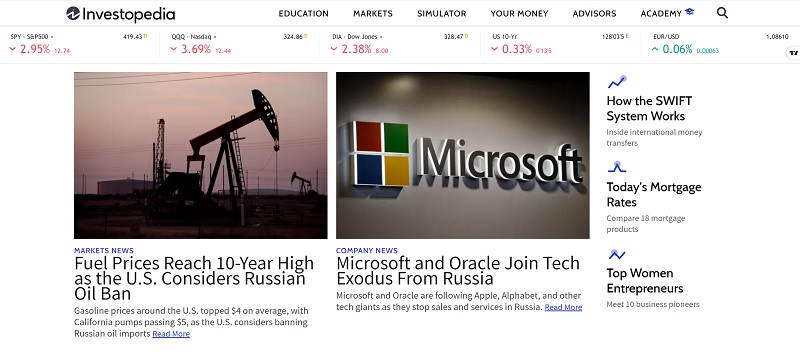
Many beginners and experienced investors like Investopedia because of its educational database, market news articles, and investing simulator.
New investors will appreciate the no-cost educational resources that many free investing apps don’t offer. You can learn about investing terms and strategies.
If you want to test investing ideas, you can make simulated investments with a $100,000 starting balance for free.
Before you invest your own money with some of the investment suggestions, you can see how they play out with paper trades first.
You can also read market news articles that tell you what’s happening in the stock market and select industries. These articles may also list stocks that are benefiting or hurt by market events.
However, Investopedia never recommends which stocks to buy or sell.
Investopedia does offer an online academy where you can take video courses to learn more about how to invest.
All the best investment sites include how-to articles, but you might enjoy this more interactive learning method.
Pros
- Great resource of information
- Simulator tool
- Educational short videos
Cons
- A technical glitch in simulator tool
- No stock recommendations
Related article: StockTwits Review: A Twitter For Stocks
7. AAII
Best value for an investment research site

You may have received envelopes in the mail from the American Association of Individual Investors (AAII). Many people regard AAII as a respected source for learning how to invest in stocks, ETFs, and mutual funds.
You can also use their model investment portfolios as an example to build your own investment portfolio.
An annual subscription only costs $49 a year. This makes AAII one of the most affordable paid investment research sites.
AAII offers other newsletters that focus on investing strategies like dividend investing. If you like the basic AAII membership, you may want to consider adding these subscriptions later.
Pros
- Depth of stock data
- Basic stock screeners
- Cost effective
Cons
- Not useful for short term investor
- Limited investment advice
Learn more: American Association Of Individual Investors (AAII) Review
8. Barron’s
Best investing site for daily market insights
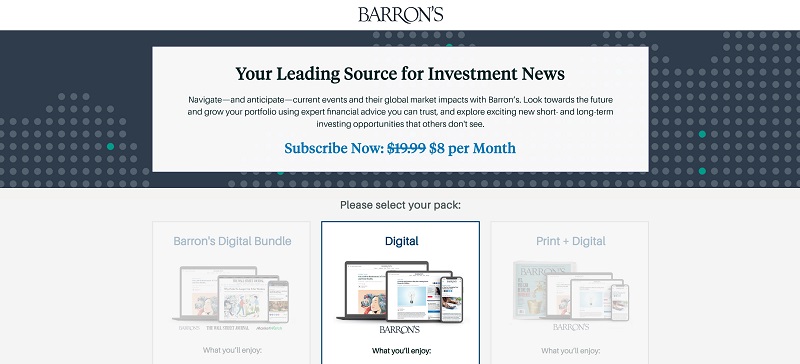
Barron’s is a highly-respected investing publication that offers daily market insights and weekly stock market recommendations. You can subscribe digitally. A weekly print newspaper is also available.
Each week, Barron’s gives readers five new investment ideas from a team of individual stock pickers. Their recommendations represent different investing strategies.
Much like Stock Advisor by Motley Fool, these ideas focus on company fundamentals so you don’t have to worry about short-term trades that require you to closely watch the markets.
If you’ve ever read a copy of The Wall Street Journal, then you will be familiar with Barron’s content format.
The same parent company owns both publications, but Barron’s focuses on stock investing while the Journal is better for business news and current events.
Pros
- Great research and data tools
- Investment picks and strategies
9. Kiplinger
Best value investing magazine

Kiplinger is best known for its monthly personal finance magazine that offers investment recommendations and money management advice for every age, including millennials. An annual subscription to the magazine costs $29.95.
Several columnists provide monthly investing ideas, plus each month features a special report of other stocks, bonds, ETFs and mutual funds you might want to buy.
You can act on one of the new recommendations or follow one of their investing lists:
- Kip Dividend 15 (Best Dividend-Paying Stocks)
- Kip 25 Mutual Funds (Best 25 Mutual Funds to Own)
If you want to invest in individual stocks, I recommend James Glassman’s column. He mentions several stocks or ETFs to invest in and covers a different investing theme each month.
As always, research each pick before you buy to determine if it’s a good fit for you.
You won’t find the same level of deep stock market analysis as some of the other recommendations on this list, but Kiplinger ranks as one of the best financial magazines.
Pros
- Tons of current articles
- Free e-newsletter
- Affordable
- Focus on long-term investing
Cons
- Published monthly
- Focused on older readers
10. CNBC
Best with free information on the stock market
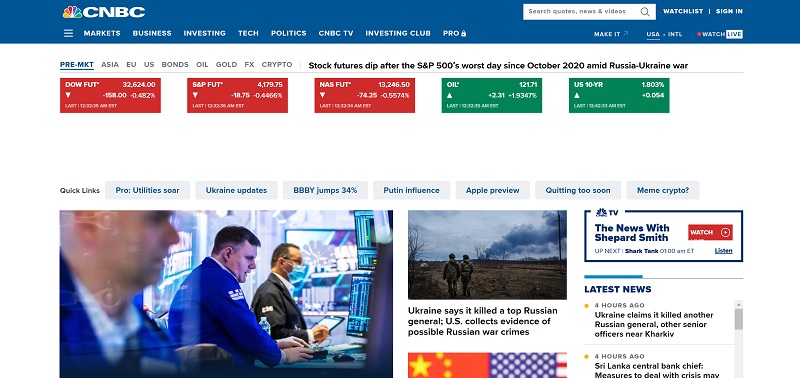
CNBC is the most-watched investing news channel. To save time (and the cost of a cable TV subscription), you can visit their website to read their numerous articles for free.
You’re going to find bullish and bearish sentiment like Seeking Alpha. Consequently, CNBC may be used as a research tool to understand the strengths and weaknesses of potential investments.
As you track your investment portfolio, the CNBC articles can help you quickly see if a stock remains a good investment.
Because CNBC is mostly news articles, make sure you read the bull and bear-side opinions for your potential investments.
Only reading bearish articles can cause you to panic sell. Likewise, only reading positive articles can cause you to buy stocks that might be too risky.
Pros
- Free trial for CNBC Pro
- Live and up-to-date business information
- Market movers
Cons
- Bearish articles
- No simulators
Are Investment Sites Worth It?
Investment sites may make buying individual stocks and sector ETFs simpler. The top sites can highlight some of the best (and worst) potential investments.
Nonetheless, you will still need to perform your own research to decide if their recommendations fit your investment strategy.
For example, investing in a fast-growing tech stock probably isn’t a good idea when you want a blue-chip dividend stock.
If the investment site charges a fee, you must decide if the quality of research is worth the cost. When the answer is “yes,” you must decide if you will buy enough stocks to justify the fee.
The Right Way to Buy Individual Stocks
Many online brokers make it easy to buy stocks without fees. Unfortunately, brokers won’t provide individual advice, so it can be easy to make a risky portfolio. These suggestions may help you as you start investing.
Diversify Your Portfolio
Buying stocks that have the most exciting headlines or investing in brands that you use can make things simple.
However, some brokers and investing sites may recommend a model portfolio of domestic and international stock and bond sectors.
You can use this recommendation to find stocks and funds that fit the recommended sectors and asset allocation.
If you have yet to invest your first dollar, consider investing in index funds and target date retirement funds first.
These funds give you exposure to most publicly traded stocks and instant diversification with low fees. As a result, you can minimize your portfolio risk.
How Much Stock to Buy
When buying stocks, it’s important to pay attention to asset allocation. You don’t want one stock to be too large of a position in your portfolio.
For instance, if a single stock is 50% of your portfolio value and the share price goes to zero, you lose half of your money.
To limit your downside risk, you may consider only having a maximum 5% portfolio allocation for each stock you buy. This means that if you have $10,000 in your brokerage account, each stock position might only be $500.
Other investors might invest as much as 15% of their portfolio in one stock. Make sure you are comfortable with the amount of stock you buy. With each purchase, make sure you maintain a diversified portfolio.
When you invest small amounts of money, you may assign a 1% or 2% allocation per stock. If the stock fails and it’s just a 2% allocation, you will only lose a small amount of cash.
Assigning a small allocation can also be good when you invest in risky stocks with a volatile share price.
Avoid Common Investing Mistakes
It’s not uncommon for new investors to have some blunders when they first get started. Investment sites may help you minimize the number of missteps you make.
Using investment sites to purchase stocks can help you avoid these common mistakes:
- Investing in company stock just because you work there
- Only buying stock for brands you use
- Trading stocks on headlines
- Investing in stocks without understanding the company’s business model
- Having a single position that’s too large for your risk tolerance
- Not performing your own due diligence
Always remember that stock investing isn’t a “get rich quick” scheme.
Do Your Research
You have many options when it comes to investing. You can use robo-advisors, mobile apps, personal retirement accounts such as IRAs, or investment management companies such as Charles Schwab or Fidelity to manage your investments.
Investment sites help educate you on the best trading platforms, exchange-traded funds, cryptocurrency and other investing platforms.
Although there are successful day traders and momentum traders, most successful investors follow the “buy and hold” approach and ignore the periodic share price dips.
This is why it’s so important to get investment advice from a third-party resource. Investing in stocks and ETFs can be easy if you use the proper resources and information to manage your investment accounts.
Comparison of Investment Sites
| Investment Site | Annual Base Price | Rating |
|---|---|---|
| Motley Fool Stock Advisor | $99 | 4.5 |
| Stock Rover | $79.99 | 4.0 |
| Investopedia | $0 | 4.0 |
| Zacks | $249 | 3.5 |
| Seeking Alpha | $359 | 4.0 |
| AAII | $49 | 4.0 |
| Barrons | $179 | 3.5 |
| Kiplinger | $29.95 | 4.0 |
| CNBC | $299.99 | 4.0 |
Summary
Professional investors rely on many of the resources mentioned above to research potential investments.
You can access the same information without paying hefty advisory fees or subscribing to a $1,000+ investing newsletter.
When you’re ready to start investing in stocks and ETFs as a DIY investor, using these investment sites can help you with your research.



